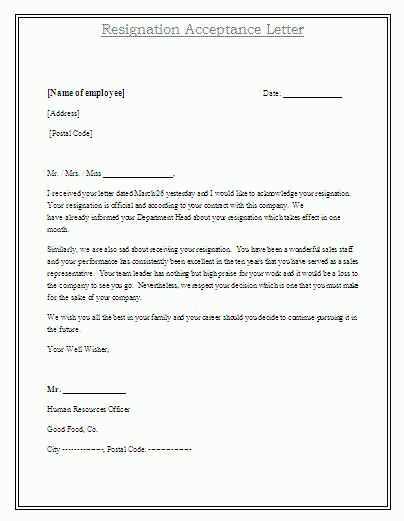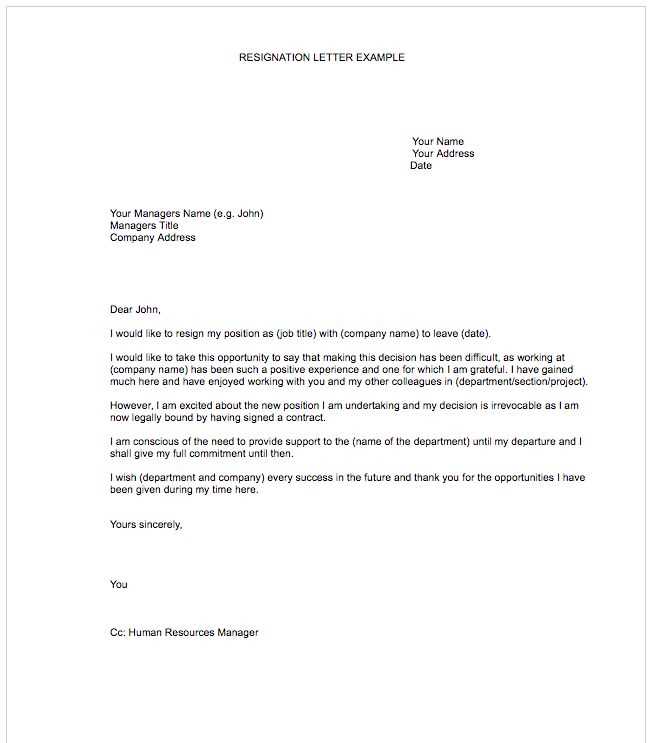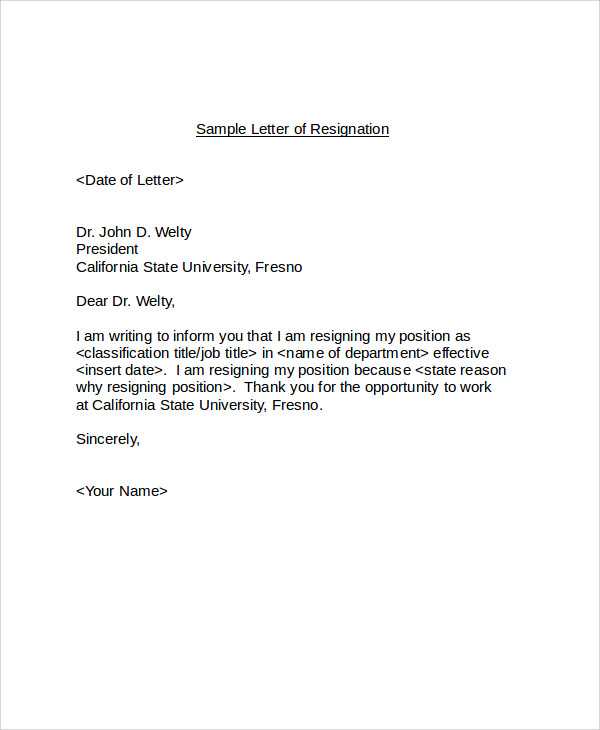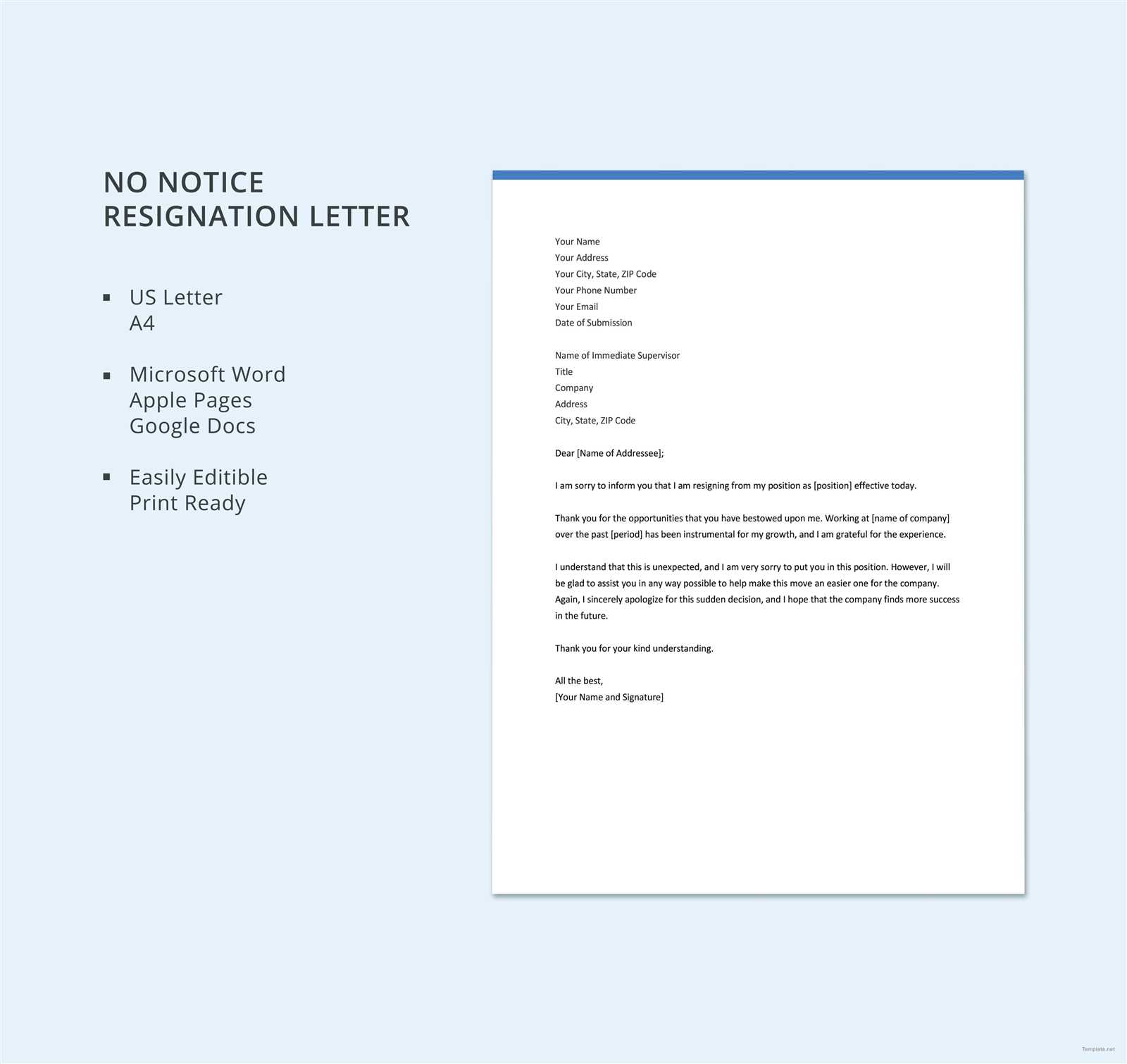Word resignation letter template

If you’re preparing to resign from your current job, a well-crafted resignation letter can make a significant impact on how you leave your position. A resignation letter provides clarity and professionalism while maintaining a positive relationship with your employer. The key is to keep it concise and respectful, focusing on expressing gratitude and providing a clear end date for your employment.
Use this Word resignation letter template as a starting point to ensure your letter is formatted correctly and conveys the right message. The structure of your letter should include a formal greeting, a statement of your intent to resign, your last working day, and a note of appreciation for the opportunities you’ve had during your time with the company.
Remember to customize the template to match your specific situation. Whether you’re leaving for personal reasons, a new opportunity, or another cause, tailoring the letter will make it feel more genuine and thoughtful. Ending on a positive note can help maintain professional relationships for the future.
Here’s the revised version:
Crafting a resignation letter requires clarity and professionalism. Start by stating your intention clearly and without hesitation. For example:
1. State Your Intention
Begin with a simple and direct statement: “I am resigning from my position as [Your Job Title] effective [Your Last Working Day].” Be sure to give appropriate notice, as required by your contract or company policy.
2. Provide a Brief Explanation (Optional)
You can add a brief sentence explaining your decision, but keep it positive and concise. For instance, “I have decided to pursue a new opportunity that aligns with my long-term career goals.” Avoid going into unnecessary details.
Next, express gratitude. Acknowledge the positive aspects of your job, the skills you’ve gained, and the support you’ve received. This leaves the door open for future professional connections.
Close the letter by offering to help with the transition. A simple phrase like, “I am willing to assist in the handover of my responsibilities” conveys professionalism and a willingness to help during the transition period.
End with a formal sign-off, such as “Sincerely” or “Best regards,” followed by your name. Keep the tone polite and respectful throughout to maintain a positive relationship with your employer.
- Word Resignation Letter Template
Creating a resignation letter in Word format requires clarity and professionalism. A well-structured letter ensures a smooth transition and leaves a positive impression. Here’s how you can quickly craft a resignation letter using Word’s built-in tools and templates.
Step 1: Select a Template
Start by opening Microsoft Word and searching for a “Resignation Letter” template. Word offers various templates that are pre-designed and easy to customize. Choose one that fits your situation. Most templates include essential sections like your contact information, date, and recipient’s name, ensuring you won’t miss any important details.
Step 2: Customize the Content
Once you’ve chosen a template, begin editing the sections. Include the following elements:
- Your details: Your full name, position, and contact information.
- Recipient’s details: The recipient’s name and position, as well as the company name and address.
- Date: The date on which you are submitting the letter.
- Body of the letter: Politely state that you are resigning, provide your final working day, and express gratitude for the opportunities you’ve had at the company.
Be direct but respectful in your tone. Avoid adding unnecessary information. The goal is to make your departure clear while maintaining professionalism. Always review the final version to ensure accuracy and clarity before submitting it.
Select a resignation letter template that reflects the tone and formality of your workplace. If your company maintains a formal environment, opt for a professional, straightforward template. This should be concise, direct, and avoid unnecessary details. For a more relaxed work culture, a slightly informal yet polite template works well, maintaining professionalism while adding a touch of warmth.
Consider Your Relationship with the Employer
Your relationship with the employer should influence the letter’s tone. If you’ve had a close working relationship, consider a template that expresses gratitude for the experience and opportunities. On the other hand, for a more formal, distant relationship, a neutral and simple resignation letter will suffice. Personalizing the template based on your workplace dynamics will help set the right tone.
Match the Template with Your Notice Period
Ensure that the template you choose aligns with the notice period required by your contract or company policy. If you’re giving the standard two weeks’ notice, select a template that allows you to clearly state your departure date. If the notice period is shorter, be sure the template reflects your specific situation and maintains a respectful tone.
Clearly state the resignation date and last working day at the beginning of your letter. This ensures that your intent is immediate and unmistakable. It’s best to specify the exact calendar dates, as this removes any ambiguity. For example, you can write, “I am resigning from my position, effective [Date], with my last working day being [Last Day of Work].”
Resignation Date

The resignation date marks the official start of your notice period. It’s typically the day you submit your letter, but make sure it aligns with the company’s required notice period. If you’re unsure, check your employment contract for the exact requirements.
Last Working Day

Indicate your last working day as the final day you will be present in the office. This date should account for your notice period and any other agreed-upon conditions. If you need to use vacation days or if your departure is contingent on the completion of specific tasks, make sure to clarify that in your letter.
- Example: “My resignation will be effective on [Date], and I will complete my final working day on [Last Working Day].”
- Example: “As per our agreement, my last working day will be [Date], after fulfilling all responsibilities.”
Use clear and concise language while remaining courteous and respectful throughout the letter. State your intention to resign directly but politely, without being abrupt. Express your gratitude for the opportunities you had during your time at the company. Acknowledge any positive experiences and relationships you’ve built with your colleagues and supervisors. This adds a touch of professionalism and shows that you are leaving on good terms.
Be sure to offer a reasonable notice period. If possible, express your willingness to assist with the transition process, whether through training a replacement or completing outstanding projects. This highlights your commitment to a smooth handover and reflects well on your character. Make your tone neutral and avoid any language that could be interpreted as negative or critical. The goal is to leave with dignity and maintain a professional reputation for future opportunities.
Avoid including negative comments about the company, colleagues, or management in your resignation letter. It’s best to keep the tone respectful and professional, even if you had disagreements. A resignation letter is not the place for airing grievances.
Don’t Over-Explain Your Reasons

There’s no need to go into great detail about why you are leaving. Simply state your decision to resign without over-explaining. A brief, clear reason is sufficient, such as pursuing another opportunity or personal reasons, without going into specifics.
Skip the Emotional Language
Avoid using overly emotional language. Keep the letter clear, concise, and to the point. While it’s understandable that resigning can be an emotional process, using too many emotional expressions may come across as unprofessional.
Additionally, refrain from making demands or expressing dissatisfaction with any terms of your resignation. Your letter should remain neutral and positive, leaving the door open for potential future opportunities or references.
Choose a professional font like Times New Roman or Arial, sized at 12 pt, to ensure readability. Stick to a clean, straightforward style with minimal distractions.
Set the margins to 1 inch on all sides. This standard margin size gives your letter a polished, formal appearance while leaving enough white space for clarity.
Use single spacing for the body of the letter. Add a double space between paragraphs to clearly separate different sections and maintain structure.
Align the text to the left for a professional layout. Avoid centering or justifying the text, as it can make your letter look uneven.
Insert a header with your contact details (name, address, phone number) and the date. Keep the font consistent with the body of the letter.
For the recipient’s information, align their name, title, and address to the left. Include a subject line if needed, and make sure it’s clearly separated from the greeting.
Proofread for typos and ensure all formatting is consistent, especially regarding font size, spacing, and alignment.
Choose the method that suits both your relationship with your employer and company culture. Here are the most common ways to submit your resignation:
- In-Person Resignation: Meet with your manager face-to-face. This shows respect and allows for a clear conversation. Be prepared for any questions they may have.
- Email Resignation: If in-person isn’t possible, send a clear and concise email. Make sure the subject line is specific (e.g., “Resignation Notice – [Your Name]”) and include all necessary details (last working day, reasons if appropriate).
- Resignation Letter: Provide a formal resignation letter. This adds structure and clarity to your decision. Attach it to your email or present it in person. Keep it professional, even if your reason for leaving is negative.
Regardless of the method, adhere to the following best practices:
- Give Sufficient Notice: Offer at least two weeks’ notice, or more if possible, to ensure a smooth transition. Some companies may require more notice, so check your contract for specifics.
- Express Gratitude: Thank your employer for the opportunities you had. Even if you’re leaving because of negative circumstances, keep it courteous and appreciative.
- Offer to Help With Transition: If appropriate, offer to assist in training your replacement or helping with other transition tasks. This shows professionalism and respect.
- Follow-Up in Writing: Confirm your resignation in writing after the conversation. This protects you legally and ensures clarity about the end date.
Whatever option you choose, aim to leave on a positive note. A smooth resignation process can preserve important professional relationships for the future.
Resignation Letter: How to Remove Redundancies and Ensure Clarity
When drafting your resignation letter, eliminating unnecessary repetition is key to keeping it clear and professional. Avoid using the same phrases or concepts multiple times, as this can make the letter feel less direct and more cluttered. Focus on expressing your gratitude and reasons for leaving concisely, without over-explaining or restating points. A well-crafted letter communicates your decision efficiently and respectfully.
Steps to Edit Your Letter
After writing your first draft, read through it to spot any sections where you’ve repeated yourself. Pay attention to phrases like “I would like to” or “I am writing to inform you”–these can often be shortened or removed entirely. Keep your tone polite but straight to the point. Remember, your goal is to leave a positive impression without overloading the reader with excessive details.
Example of Streamlined Letter
| Original Text | Revised Text |
|---|---|
| “I am writing to inform you that I am resigning from my position. I would like to express my gratitude for the opportunity I have had at this company. I am very thankful for all the experience and knowledge I’ve gained during my time here.” | “I am resigning from my position and want to thank you for the opportunity to work here and the experience I gained.” |
In this example, the letter is more straightforward, removing redundancies and maintaining the same message. The revised version is shorter but still conveys appreciation and respect.